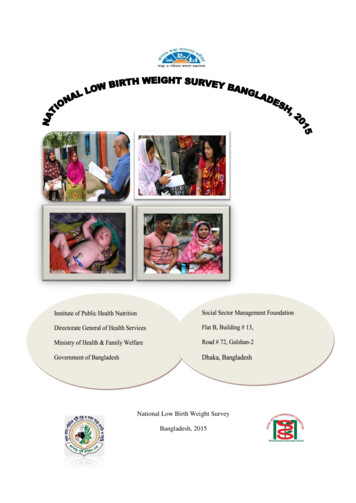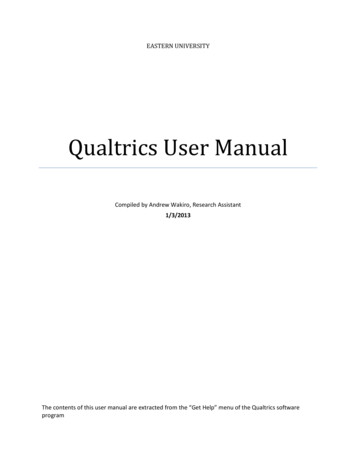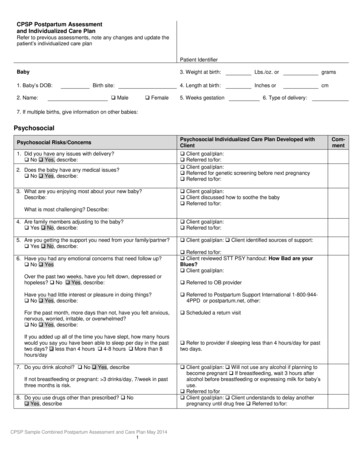
Transcription
National Low Birth Weight SurveyBangladesh, 2015
PSSMRTD/NLBWS/FINAL REPORT/ 080/201621.12.2016DirectorInstitute of Public Health Nutrition (IPHN)Directorate General of Health ServicesMinistry of Health & Family WelfareGovernment of the People‟s Republic of BangladeshSubject: Submission of the final draftKindly receive the final draft of the survey report on the „National Low Birth weightSurvey‟. This has been developed based on the opinions and suggestions received inthe two technical dissemination sessions that were organized by IPHN.As per the last technical dissemination session suggestion, you are requested to kindlydistribute this final draft among all the technical experts and participants of the twotechnical dissemination sessions for their final suggestions and views.RegardsA M Zakir HussainCEO, SSMF and Team LeaderNational Low Birth weight Survey
Published by:Institute of Public Health Nutrition (IPHN)Directorate General of Health ServicesMinistry of Health & Family WelfareGovernment of the People‟s Republic of BangladeshMohakhali, Dhaka 1212Report prepared by:Partners in Social Sector management Research Training & Development (PSSMRTD)Flat B, Building No. 13Road No. 72, Gulshan-2Dhaka 1212, BangladeshCover Photo: PSSMRTDDesign & Layout: PSSMRTDNational Low Birth-weight Survey, Bangladesh, 2015Page 1
TABLE OF CONTENTSTITLEPAGE NO.List of Tables4List of Figures5List of rvey area36Survey population36Hypothesis and the relevant variables36Sample size36Sampling technique36Inclusion and exclusion criteria37Recruitment of data collectors37Measurement Instruments38Recruitment of Supervisors and QI Officers39Measurement process40Data collection process40List of instruments and equipment43Controlling biases43Training for quality improvement43Monitoring and supervision plan44Data management plan45Ethical issues46Results47Family characteristics of the studied pregnant women47Religion47Family structure47Occupation (husbands' and pregnant women's)49Literacy (husbands' and pregnant women's)50National Low Birth-weight Survey, Bangladesh, 2015Page 2
Living standard57Housing type57Type of toilet58Source of water for cleansing utensils61Source of light64Demographic characteristics65Age at marriage65Economic condition67Saving situation69Nutritional practices72Family backyardhorticulturegardeningand72Rearing of animals and birds75Feeding practices77Health practices (smoking, vaccination, micronutrient, rest,mental peace, cleanliness, heavy work)95Biochemical/ Clinical conditions and physical appearance duringpregnancy120Child birth related information127Birth weight145Birth s187Annexure- Study instruments188National Low Birth-weight Survey, Bangladesh, 2015Page 3
LIST OF TABLESTITLEIntroduction sectionTable 1. Incidence of low birth weight and intrauterine growth retardationTable 1. List of instruments and equipmentPAGE No.192143Result section47Table 1. Fruit trees in family garden72Table 2. Care during pregnancy by urban (slum and non-slum) and rural areas(summary)107Table 3. Birth length (cm) by gestational weeks, division and urban (slum and nonslum) and rural areas154Table 4. Birth length by gestational week, division and sex158Table 5. Mean and standard deviations of birth weight by division and sex159Table 6. Summary estimates of length160Table 7.1 Variables found to be associated through bivariate analyses160Table 7.2 Variables found associated with birth weight through multiple regression163Table 7.3 Variables associated significantly with birth length (bivariate analysis)163Table 7.4 Variables associated significantly with birth length (linear regression)164Discussion section164Table 1. Birth weight in gm by sex and urban slum and non slum165Table 2. Birth length in gm by sex and urban slum and non slum165Table 3. Parity in urban slums and non slums165Table 4. Parity by urban and rural areas165Table 5. Brcakdown of number of birth in rural and urban areas166Table 6. Comparison between 2003-2004 and 2015-2016 survey166Table 7. Comparison between Urban Health Survey 2013, Bangladesh Demographic &Health Survey (2014) and NLBS 2015170Table 8. Studies on birth weight in Bangladesh174Table 9. Prevalence of low birth weight and intra-uterine growth retardation in SouthEast Asian countries176Table 10. LBW in South Asia*176Table 11. Birth weight and birth length by gestation177National Low Birth-weight Survey, Bangladesh, 2015Page 4
LIST OF FIGURESTITLEPAGE No.Introduction part19Figure 1. Incidence of LBW at term in selected Asian countries20Figure 2. Incidence of LBW at term in selected African countries20Methodology part36Fig 1. Instruments used for measuring weight and length of newborn47Result part47Fig 1. Religion by division and urban (slum and non slum) and rural areas48Fig 2.1 Main occupations of the pregnant women and their husbands by urban and ruralareas51Fig 2.2. 2.3 Occupations of the husbands of the pregnant women by division and urban(slum and non-slum) and rural areas52-53Fig 3.1 Literacy of pregnant women and their husbands (summary) by urban (slum andnon-slum) and rural areas54Fig 3.2, 3.3 Literacy of pregnant women by division and urban (slum and non-slum) andrural areas55-56Fig 4. Housing type (summary) by urban (slum and non-slum) and rural areas57Fig 5.1 Type of toilets (summary) by urban (slum and non-slum) and rural areas58Fig 5.2, 5.3 Type of toilets by division and urban (slum and non-slum) and rural areas59-60Fig 6.1 Source of water for cleansing utensils (summary) by urban (slum and non-slum)and rural areas61Fig 6.2, 6.3 Source of water for cleansing utensils by division and urban (slum and nonslum) and rural areas62-63Fig 7. Source of light (summary) by urban (slum and non-slum) and rural areas64Fig 8.1 Age at marriage (summary) of husbands and pregnant women below marriageableage by urban (slum and non-slum) and rural areas65Fig 8.2 Age at marriage of husbands and pregnant women below marriageable age bydivision and urban (slum and non-slum) and rural areas67Fig 9. Possession of assets (summary) by urban (slum and non-slum) and rural areas6810.1 Saving situation (summary) by urban (slum and non-slum) and rural areas69Fig 10.2, 10.3 Saving situation by division and urban (slum and non-slum) and rural areas70-71Fig 11.1, 11.2 Backyard kitchen garden by division and urban (slum and non-slum) andrural areas73-74National Low Birth-weight Survey, Bangladesh, 2015Page 5
Fig 12.1 Rearing of poultry and cattle (summary) by urban (slum and non-slum) and ruralareas75Fig 12.2 Rearing of poultry and cattle by division and urban (slum and non-slum) andrural areas76Fig 13.1.1-13.8.2 Consumption of fish, meat, egg, milk, fruit, vegetables and oil bydivision and urban (slum and non-slum) and rural areas79-94Fig 14.1, 14.2 Smoking habit of husbands and pregnant women by division and urban(slum and non-slum) and rural areas97-98Fig 14.3 Smoking habit of pregnant women and their husbands (summary) by urban(slum and non-slum) and rural areas99Fig 15. The rate of TT-5 vaccination by division and urban (slum and non-slum) and ruralareas110Fig 16. Intake of iron folate by division and urban (slum and non-slum) and rural areas101Fig 17. Intake of vitamin/ calcium tablets by division and urban (slum and non-slum) andrural areas102Fig 18. Rest taken during pregnancy by division and urban (slum and non-slum) and ruralareas103Fig 19. Degree of mental peace in pregnant women by division and urban (slum and nonslum) and rural areas104Fig 20. Degree of cleanliness in pregnant women by division and urban (slum and nonslum) and rural areas105Fig 21. Heavy work done by pregnant women by division and urban (slum and non-slum)and rural areas106Fig. 22.1, 22.2 Height of the husbands of the pregnant women by division and urban(slum and non-slum) and rural areas109-110Fig 23.1, 23.2 Height of the of the pregnant women by division and urban (slum and nonslum) and rural areas111-112Fig 24.1 Height of the pregnant women below and above 145 cm by division and urban(slum and non-slum) and rural areas113Fig 24. 2 Height of pregnant women 145 cm (summary) by urban (slum and non-slum)and rural areas114Fig 25.1, 25.2 Initial weight of the pregnant women by division and urban (slum and nonslum) and rural areas115-116Fig 25.3 Initial weight of the pregnant women (summary) by urban (slum and non-slum)and rural areas117Fig 26.1, 26.2 Weight of the husbands of the pregnant women by division and urban(slum and non-slum) and rural areas118-119Fig 27.1, 27.2 Biochemical/ clinical conditions of the pregnant women by division andurban (slum and non-slum) and rural areas121-122Fig 27.3, 27.7 Biochemical/ clinical conditions of the pregnant women (summary) byurban (slum and non-slum) and rural areas123-125National Low Birth-weight Survey, Bangladesh, 2015Page 6
Fig 28. Physical appearance of the pregnant women by division and urban (slum and nonslum) and rural areas126Fig 29.1, 29.2 Gestational weight gain by division and urban (slum and non-slum) andrural areas128-129Fig 29.3 Gestational weight gain by division and urban (slum and non-slum) and ruralareas130Fig 30.1 Pregnancy outcome by division and urban (slum and non-slum) and rural areas131Fig 30.2 Pregnancy outcome by urban (slum and non-slum) and rural areas132Fig 31.1, 31.2 Sex distribution of live births by division and urban (slum and non-slum)and rural areas133-134Fig 32.1, 32.2 Place of delivery by division and urban (slum and non-slum) and ruralareas136-137Fig 32.3 Place of delivery (summary) by urban (slum and non-slum) and rural areasFig 33.1, 33.2 Process of delivery by division and urban (slum and non-slum) and ruralareasFig 33.3 Process of delivery (summary) by urban (slum and non-slum) and rural areas138139-140141Fig 34.1, 34.2 Provider of child delivery by division and urban (slum and non-slum) andrural areas142-143Fig 34.3 Provider of child delivery (summary) by urban (slum and non-slum) and ruralareas144Fig 35.1- 35.4 Birth weight (unadjusted) by division and urban (slum and non-slum) andrural areas146-149Fig 36. Birth weight below and above 2.5 Kg by division and sex150Fig 37. Birth weight (summary) by sex and urban areas (slum and non-slum)151Fig 38. Birth weight (summary) by gestational period and other measures151Fig 39. Average birth length (summary) by urban (slum and non-slum) and rural areas152Fig 40. Average birth length (summary) by division and sex152National Low Birth-weight Survey, Bangladesh, 2015Page 7
LIST OF ABBREVIATIONSBBSBangladesh Bureau of StatisticsBMIBody mass indexBRACBangladesh Rural Advancement CommitteeCEGCore expert groupcmCentimeterCSBACommunity skilled birth attendantC-sectionCaesarian sectionDGHSDirectorate General of Health ServicesDPEDirectorate of Primary EducationDPHEDepartment of Public Health EngineeringDWADepartment of Women AffairsEDDExpected date of deliveryEOCEmergency obstetric careERDExternal relation divisionFMField Operations ManagerFSField supervisorFigFigureFWVFamily Welfare Visitorg/ gmGramHKIHellen Kellar InternationalHSCHigher Secondary School CertificateHt/ htHeightICDDR/BInternational Center for Diarrheal Diseases Research/ BangladeshIMEDInformation Monitoring and Evaluation DivisionINFSInstitute of Nutrition and Food SciencesIPHNInstitute of Public Health NutritionISRTInstitute of Statistical Research and TrainingIQIntelligent qoutientIUGRIntrauterine growth retardationKgKilogramLBWLow birth weighLMPLast menstrual periodMCHTIMaternal and Child Training InstituteMCWCMaternal and Child Welfare CenterMoHFWMinistry of Health & Family WelfareMUACMid upper arm circumferenceNational Low Birth-weight Survey, Bangladesh, 2015Page 8
NSample sizeNGONon-government organizationNNSNational Nutrition CouncilOROdds ratioPIPonderal indexPRCPeople's Republic of ChinaQCQuality controlQIQuality improvementRFAResident Field AssistantSACMOSub-assistant Community Medical OfficerSGASmall for gestational ageSPSSStatistical Package for Social ScienceSSCSecondary School CertificateSSMFSocial Sector Management FoundationTAPPTechnical Assistance Project ProformaToRTerms of referenceUNGAUnited Nations General AssemblyUNICEFUnited Nations Children FundUSAUnited States of AmericaWHOWorld Health OrganizationWt/wt.WeightNational Low Birth-weight Survey, Bangladesh, 2015Page 9
FOREWORDSNational Low Birth-weight Survey, Bangladesh, 201510Page
PREFACENational Low Birth-weight Survey, Bangladesh, 201511Page
ACKNOWLEDGMENTWe are grateful to the Institute of Public Health Nutrition, Directorate General of Health Services,Ministry of Health & Family Welfare, Government of the People‟s Republic in trusting us inconducting this nation-wide survey. We will fail in our expression of the deep sense of indebtedness ifwe do not mention in particular the names of Dr. Alamgir Hossain the former Director of the Instituteand Line Director of the National Nutrition Services (NNS) and Dr. Muzaherul Islam the presentDirector and Line Director, for their unconditional support to the carrying out of this project. In thesame breath we would also express our profound thanks to Dr Moudud Hossain Deputy Director ofthe Directorate General of Health Services and Program Manager, NNS and Mr. Aman Ullah, DeputyProgram Manager respectively of NNS, especially for their supportive supervision and monitoring offield work, which has contributed to the improvement of the data collection process and accuracy.We are thankful to our data collectors and supervisors. They were the most important foot soldiers ofthis survey. Their dedication and interest toward the work were amazing and beyond our a prioribelief. We were in fact surprised to see how popular and friendly they were in the community. Theyknew the families of the women they followed up for an entire period of about nine months evenbefore the study actually begun and also knew these women by name. The supervisors also exhibitedtheir utmost dedication to the work. They in fact resided in the field for the entire period of this work.The support received from our partners- Dhaka Shishu (Children) Hospital, Bangladesh Associationfor Maternal and Neonatal Health (BAMANEH) and the Institute of Nutrition and Food Sciences(INFS) of the Dhaka University, was unprecedented and truly valuable, which came in the form oftechnical advice and training to the field supervisors and quality improvement officers. Statisticalanalysis was done Dr. Taslim Sazzad Mallik of the Dept. of Statistics of Dhaka University. We arethankful to him also, for the hard work, he undertook.Finally, we would like to express our gratitude towards our data entry and analysis partner- NKEnterprise. They have taken considerable amount of pain on different occasions in providing differentpieces of information in summary form, besides what was agreed upon in the beginning- only dataediting and entry for statistical analysis.A M Zakir HussainChief Executive OfficerSocial Sector Management FoundationNational Low Birth-weight Survey, Bangladesh, 201512Page
SUMMARYBACKGROUNDLow birth weight has been defined by the World Health Organization (WHO) as weight at birth ofless than 2,500 grams1, based on epidemiological observations that newborns weighing less than2,500 g are about 20 times more likely to die than heavier babies.Low birth weight is either the result of preterm birth ( 37 weeks of gestation) or due to restricted fetalgrowth, i.e., due to intrauterine growth retardation. Low birth weight is also associated with poorcognitive development, and chronic adulthood diseases- type 2 diabetes, hypertension andcardiovascular disease.It also leads to poor health through reducing immunity and increasingsusceptibility to disease. Intra-uterine growth retarded (IUGR) and LBW infants are more susceptibleto hypoglycemia and to birth asphyxia. In a substantial number of studies they were seen to sufferfrom more diarrhea and pneumonia for a few months after birth, showing that LBW may also be a riskfactor for post-neonatal death. Undernutrition in mid-pregnancy may also impair development of theimmune system.Weight at birth is a strong predictor for size in later life because most IUGR infants do not catch-up tonormal size during childhood. Also, undernutrition that affects head circumference before 26 weeks ofpregnancy has a greater impact on neurologic function than does undernutrition later in pregnancy.The adverse effects of early childhood undernutrition on behavior and cognitive development may notbe fully redressed, even with better diet and care later.LBW could be the main reason why more than 50percent of the children in South Asia areunderweight. Infants who weigh 2,000-2,499 gm at birth have a four-fold higher risk of neonataldeath than those who weigh 2,500-2,999 gm, and a ten-fold higher risk than those weighing 3,000 3,499 gm.Factors affecting the duration of gestation and fetal growth, influence the birth weight. They relate tothe baby, the mother, or the environment and play an important role in determining the birth weightand the future health of the infant. Birth weight is affected to a great extent by the mother‟s own fetalgrowth and her diet from birth to pregnancy, and determining her body composition prior toconception. Mothers in deprived socio-economic conditions tend to have low birth weight infants. Inthose settings, the infant‟s low birth weight emanates from the mother‟s poor nutrition and health overa long period, including during pregnancy, the high prevalence of infections, or from pregnancycomplications, often related to poverty. Hard physical work during pregnancy may contribute to poorfetal growth.Mothers who are younger ( 20 years) or older ( 35 years) have also been found to give birth to lowbirth weight newborns in comparison to those women who are aged 20-35 years. In 1992, as perWHO and UNICEF, the low birth weight rate for industrialized countries was around 7 per cent, andin less developed countries between 5 and 33 per cent, with an average of 17 per cent. Half of all lowbirth weight babies are known to be born in South-central Asia, where about 27 per cent of all infantsweigh less than 2,500 g at birth. In Bangladesh, on the other hand, the first ever low birth weightsurvey conducted in 2003-2004, found the rate of low birth weight to be 36percent. In developing1The 29th World Health Assembly (1976) agreed that: “Low birthweight is a weight at birth of less than 2,500 g(up to and including 2,499 g) irrespective of gestational age.”National Low Birth-weight Survey, Bangladesh, 201513Page
countries, the majority of LBW newborns are small, but are not born prematurely. Nevertheless,6.7percent of LBW infants are born preterm in developing countries. In Bangladeshi cultural contextit is difficult to identify preterm birth, as has been seen in this study, because women do not identifythemselves as pregnant, unless they miss at least two or three menstrual cycles, for the sake of surety.The fetus is known to increase maximally in length at 20-30 weeks of gestation, and in weight duringthe third trimester. Over-gestation has been found, in this study, contrarily to give birth to smallerlength and low birth weight newborns.Maternal undernutrition has been found to be the major determinant of IUGR in developing countries(about 50percent of all IUGR in rural areas of developing countries is attributable to low weight andshort stature). Poor physical condition was a common feature among the pregnant women in thisstudy-with average height being 5 feet and average weight 49.1 Kg (lesser in the rural areas) in thestudy areas. Majority of LBW is caused by premature delivery (in this study almost half were bornpremature with LBW), cigarette smoking during pregnancy, which is probably the most importantcause of IUGR (no relation was found in this study between LBW and smoking), followed by lowgestational weight gain (not a case in this survey, as the average weight gain during pregnancy was8.2 Kg).There is increasing evidence that deficiencies of some micronutrients, such as folic acid,increase the risk of preterm delivery. Anemia was detected in 54.8 percent of the pregnant women inthis study.According to a WHO collaborative center study, a preconception weight of 40 kg (assuming averageheight is 150 cm) has been proposed as a useful cut-off for predicting IUGR risk in developingcountries. Maternal weight during gestation predicts IUGR risk slightly better than pre-pregnancyweight because it considers weight gain both in pregnant women and the fetus. The study found thatjust a low maternal BMI was a poorer predictor of IUGRthan either pre-pregnancy maternal weight orattained weight during pregnancy. This implies that a controlled study is required on what would bethe standard weight gain during the gestational period in Bangladesh and also what would be effect ofdifferent scales of weight gain on the babies born with different birth weight and length. At the sametime finding the predictors of IUGR would also be warrantable.Maternal height contributes to total maternal mass, but it has less value than weight for predictingIUGR. Low height is rather a good indicator of obstetric complications. Mid-pregnancy maternalweight gain and increments in thigh skin-folds were significantly associated with the newborn'slength, weight and head circumference and were more effective predictor of birth weight and othernewborn outcomes. In this study the pregnant women followed up had an average height of 150.1 cmand average weight of 55 Kg, the average BMI being 21.7. So BMI can hardly be the determinant ofthe 73 percent of IUGR that was experienced in this study. Follow up of the women based on theirpre-pregnancy study may give some clue in this regard.Supplementation of moderately malnourished women produces an increase in birth weight but haslittle impact on maternal weight gain. However, when seriously malnourished women aresupplemented they cannot 'afford' to direct the energy to the fetus and therefore such supplementationimproves maternal weight gain more than birth weight. This study has gauged into the feedingpractices, consumption of none of fish, meat, egg, milk, fruit and vegetables could be considered asadequate as no more than 20percent of the families could say that they had good amount ofconsumption of these food items. Only one third of the families had good consumption of vegetables.National Low Birth-weight Survey, Bangladesh, 201514Page
Adolescent pregnancy has been associated to a higher newborn mortality rate, low birth weight andstill birth in newborns. These newborns are also prone to die within few weeks of their birth incomparison to babies born to women aged 20-24 years. Age at first marriage of the study womenwere: 18 years (69.8percent), 18 years (30.2percent) in this study. A comparative study would beuseful to prove the ill effects of adolescent marriage.Aim of this studyThis study, being reported, was undertaken with the aim to provide nationally representative data onthe prevalence of LBW including IUGR, and birth length of newborns, against which nationalinterventions may be planned and implemented and progress may be measured towards the impact ofrelevant interventions.Period of the studyThe study was undertaken over a period of May 2015 to April 2016 (11 months) in the field. Threemonths were taken for data entry, statistical analyses and report writing.METHODOLOGY OF THE STUDYData collection instruments were first developed in English by the team leader and the consultants,translated into Bangla, pre-tested, finalized and printed. Besides the questionnaire the otherinstruments used were: Salter and metallic spring type baby weighig machine (used in hospitaldelivery and home delivery respectively), wooden infantometer; bathroom scale; sphygmomanometer;glucometer and needle; gauze and spirit; thermometer; hemoglobin measuring strips; acetic acid andglass tube for measuring albumin in urine; and wooden length measuring scale.One hundred and two data collectors, sixteen supervisors, four quality improvement officers, one fieldmanager, one research officer, one team leader and four consultants were involved in data collection,assurance of data validity and for statistical analyses. Supervisors and quality improvement officerswere trained for five days theoretically and practically, on interviewing and on taking clinical andphysical measurements.For the study one rural cluster (a community clinic catchment population) from each district wastaken, based on the working area of the best known community skilled birth attendant (CSBA) in thedistrict. Fifty pregnant women were identified (either through test kits or self declaration of thepregnant women) and listed by the CSBAs in each rural cluster. In urban areas 18 clusters were takenfrom among the most identifiable slums (from older districts), that are closest to the best knownCSBA in the city/ town. Eighteen close-by non slum clusters were taken, in addition. From each ofthe urban clusters, slum or non-slum, 35 pregnant women were enlisted. The two urban clusters inMymensingh were changed to rural clusters, to represent the proportionality of the rural and urbansample size, more or less (27:73 urban and rural sample units)CSBAs were trained on collection of data on demographic, economic, educational, occupational,nutritional and feeding status and practices and other health status and practices; measuring physical,clinical and nutritional conditions of these women and also on measuring the weight and length of thenewborns. Health care and practices during pregnancy were also recorded and medical conditionsrelated to present and past pregnancies were also noted. Past and present child delivery practices, suchas, place of delivery, conductor of child delivery, time of delivery, condition of the newborn at theNational Low Birth-weight Survey, Bangladesh, 201515Page
time of delivery, pregnancy outcome etc. were recorded. Finally the birth weight and the birth lengthof the newborns were recorded.Each supervisor visited one of the data collectors every day and worked the whole day with the datacollector. Supervisors‟ meetings were held once in two months in the project head office to review thequestionnaires collected before coming to Dhaka, and to resolve issues encountered during datacollection. These meetings also provided refreshers' training and involved the other partners of thestudy. Field Manager, research officer and the team leader visited the study clusters regularly (theteam leader visited 40percent of the clusters). Field manager compiled the supervisory and QIofficers‟ reports for the team leader. Manager, human resources also communicated with thesupervisors and data collectors every day. IPHN officials (line director, program manager and deputyprogram manager) also visited survey works in the fieldThe total sample size was 4,500 pregnant women, of who 102 were missed on follow up, before theirdelivery. The sample size was determined based on an analytic design – a two sampled, two tailedtest, with 95percent confidence level and 95percent power to detect difference, if any, between thetwo samples coming from different divisions.Demographic, economic, social (literacy), and physical conditions (height and weight of husbands)and possible nutritional practices were collected once. Data on feeding practices were collected onweekly basis. Data on clinical (weight during pregnancy, blood pressure, anemia, blood sugar, urinein albumin) and medical conditions (illnesses or other medical complaints and problems, e.g., fever,eclampsia, edema, goiter etc.) were collected on a trimester basis an finally the child birth relatedinformation as the penultimate information.Data were edited, coded, cleansed, entered and analyzed by the data management partner of the SocialSector Management Foundation. Data were treated statistically through the Statistical Package forSocial Science (SPSS), version 20. Team leader kept track of data validity at data collection level andat data entry level. Reports were prepared through a consultation process between the consultants andthe partners involved in the study. The report was finalized after inputs from the technical committeeof the National Nutrition Services (NNS), the technical staff of the Institute of Public Health Nutrition(IPHN) and after two consecutive meetings of experts, held at IPHN.FINDINGSAbout 95 percent of pregnant women in this study were housewives. The literacy rate of the pregnantwomen in this study was as follows: illiterate (4 percent), 15.8 percent studied up to primary schoolwithout completion, 27.9 percent completed primary education, 31.5 percent studied up to SSCwithout completion, 11.8 percent completed SSC, 6.4 percent completed HSC and 2.6 percent wasgraduates and above).Housing type-wise 7.2 percent of the studied women were living in houses made of mud, 0.6 percentin thatched roofed houses, 0.1 percent houses made of roof with polythine, 23.6 percent houses madeof brick wall, 63.2 percent made of tin roof, 1.8 percent made of bamboo and 3.5 percent houses buildwith concrete roof and brick wall. The toilets being used were as follows: modern (9.3 percent),sanitary 81.9 percent), dug/pit (7.4 percent), hanging and open space (each 0.7 percent).While 18 percent and 74 percent of the studied families were using tap and tube well waterrespectively for cleansing their utensil, 0.8 percent and 10.2 percent were using well and pond waterfor the same purpose. Among these families, 82.1 percent were using electricity for lighting theirNational Low Birth-weight Survey, Bangladesh, 201516Page
houses, 8.1 percent solar energy and 10.9 percent oil lamps/ hurricane. Among these families, 63.3percent had electric fan in thei
Table 6. Comparison between 2003-2004 and 2015-2016 survey 166 Table 7. Comparison between Urban Health Survey 2013, Bangladesh Demographic & Health Survey (2014) and NLBS 2015 170 Table 8. Studies on birth weight in Bangladesh 174 Table 9. Prevalence of low birth weight and intra-uterine growth retardation in South East Asian countries 176










